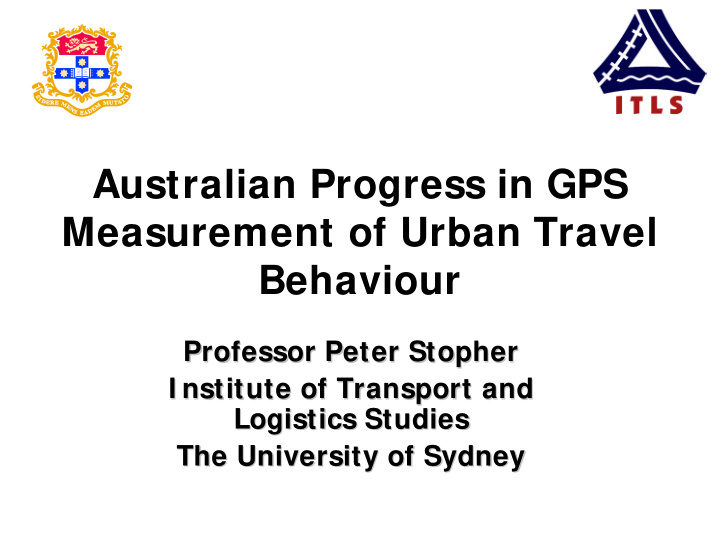



Australian Progress in GPS Measurement of Urban Travel Behaviour Professor Peter Stopher Professor Peter Stopher I nstitute of Transport and I nstitute of Transport and Logistics Studies Logistics Studies The University of Sydney The University of Sydney
Outline Outline • I ntroduction and Background • Recent Projects at I TLS • Survey Procedures with GPS • Results of GPS Data Collection • Variability of Travel Behaviour • Conclusions May-June 2008 Australian Developments in GPS 2
I ntroduction and I ntroduction and Background Background • Global Positioning System devices first used in travel behaviour research in 1995 – I nitial devices were vehicle based – Portable/ wearable devices emerged in late 90s • GPS devices have become increasingly sophisticated and available as personal tracking devices • Most recent Australian uses of GPS have been for: – TravelSmart evaluations – Validation and analysis of traditional household travel surveys May-June 2008 Australian Developments in GPS 3
I ntroduction and I ntroduction and Background Background • I TLS has been developing GPS for the past 7 years – Specifying improved capabilities for GPS devices – Refining survey procedures for use with GPS devices – Developing software to process the results – Exploring potential to replace travel diaries • A number of projects have been conducted with GPS May-June 2008 Australian Developments in GPS 4
Recent Projects Recent Projects • Validation of the Sydney Continuous Household Travel Survey with GPS (2001-2004) – Used mainly in-vehicle devices and some portable devices – Households recruited by door knocking – Recruited after agreeing to participate in the Sydney HTS – Participants asked to carry GPS devices for 3-4 days – 1 day analysed May-June 2008 Australian Developments in GPS 5
Recent Projects Recent Projects • Evaluation of “Households on the Move” TravelSmart intervention in Canberra (2003-2004) – Used same mix of GPS devices as previous project – Participating households recruited by door knocking – Households asked to participate in two waves of a panel (before and after) – Both TravelSmart and non-TravelSmart households recruited – Participants asked to carry GPS devices for a week in each wave May-June 2008 Australian Developments in GPS 6
Recent Projects Recent Projects • TravelSmart Evaluation of Households in the West, Adelaide (2005-2008) – Used a newer portable device for all participants (made in South Australia) – Established a panel of 200 households – Panel recruited by telephone – Panel members asked to carry GPS devices for 7 days once each year for three years – Subsample carried GPS for 15 days in two waves – Project recently completed – results not yet publishable May-June 2008 Australian Developments in GPS 7
Recent Projects Recent Projects • Methodology for Long Range Monitoring of Travel Behaviour Change (2005-2006) – Pilot survey to research some questions on GPS feasibility – Panel of 50 households recruited by telephone – Panel members asked to carry GPS devices for 28 days in Waves 1 and 2 – Six months between waves – Panel members asked to carry GPS devices for 15 days in Wave 3 May-June 2008 Australian Developments in GPS 8
Current and Future Current and Future Projects Projects • Pilot GPS Validation of VI STA07 (2007) – Households recruited by door knocking – Participants asked to carry GPS devices for one week – Recruitment of households only after agreement to undertake VI STA07 survey – One week included diary day of VI STA07 – Results provided to the client a month ago May-June 2008 Australian Developments in GPS 9
Current and Future Current and Future Projects Projects • Long-Term Monitoring of Travel Behaviour Change (2007-2013) – Households recruited by telephone – Panel of 120 households recruited – Participants asked to carry GPS devices for 15 days once per year for six annual waves – Panel rotation will be undertaken on a four-year basis May-June 2008 Australian Developments in GPS 10
Advantages of GPS Advantages of GPS • Passive method requiring very little from the respondent • Records data very accurately about – Routes used – Distance travelled – Time taken – When and where the trip takes place. • Provides a means to obtain multi-day travel data • Records distances for all modes of travel – Permits the analyst to infer travel mode, estimate VKT and PKT – Captures walk and bicycle travel • Data can potentially serve a number of additional uses, e.g., – Travel speed by time-of-day and route – I nputs for fuel consumption and emissions estimates – Measures of physical activity and health. May-June 2008 Australian Developments in GPS 11
Evolution of Portable Evolution of Portable GPS Devices GPS Devices May-June 2008 Australian Developments in GPS 12
GPS Device Used in GPS Device Used in South Australia and South Australia and Long- -Term Pilots Term Pilots Long May-June 2008 Australian Developments in GPS 13
GPS Device Used in GPS Device Used in SA Projects SA Projects • Similar in size to mobile phone • Weighs about 110 grams • Has 8 Mb memory – sufficient for more than a month of data collection • Powerful antenna/ receiver capable of receiving signals in: – Trains and buses – I nside a handbag or in a pocket – I n the glove box of a car – I nside a house – I n most shopping centres • Contains its own battery May-June 2008 Australian Developments in GPS 14
GPS Device Used in GPS Device Used in SA Projects SA Projects • Battery life and power management are an issue • Current battery life is about 8 hours – Power management involves the device “sleeping” after no movement for 2 minutes – Wakes up every 3 minutes to check for movement – Can result in missing start of a trip May-June 2008 Australian Developments in GPS 15
Recommend
More recommend